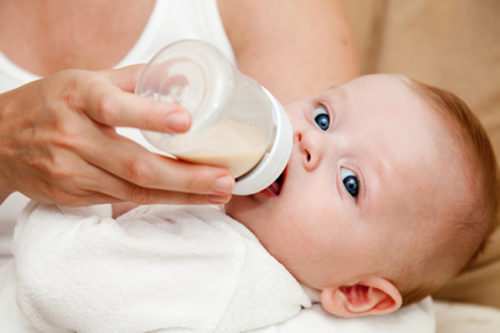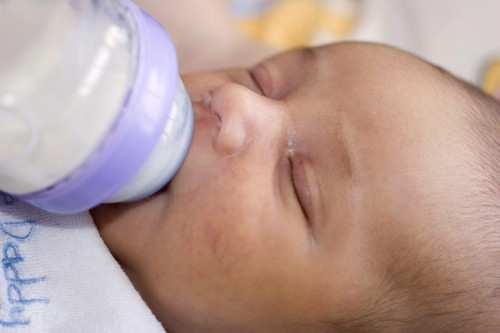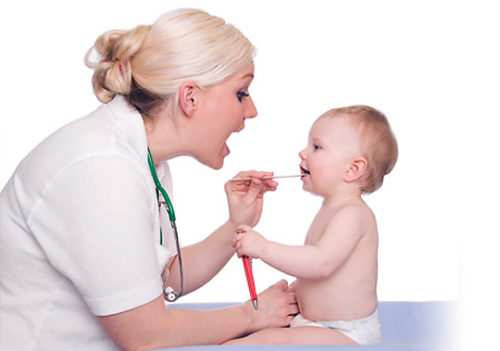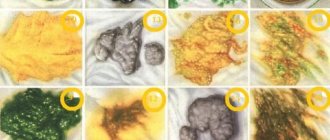Features of artificial chairs
Feces in children who are bottle-fed differ in color and consistency - it is thicker and more uniform, and has a yellow-brown tint. The artificial one is released from feces less frequently (can be up to once every two days). This is due to the fact that the baby is fed the same adapted formula every day.
Breastfed babies are prone to frequent constipation. Formulas are absorbed worse by the digestive system than breast milk.
The greenish color may appear as a result of changes in the intestinal tract or be the result of more serious disorders. The mixtures contain many vitamins and minerals, including iron. It is this that can give the stool a green color. In any case, if the color of the stool changes, you should more closely monitor the behavior and condition of the baby.
If the child is active, sleeps peacefully and eats well, then there is no reason to worry.
If green stool is accompanied by symptoms that are not typical for a baby, then this is a reason to visit a doctor and get tested.
- The child breaks out in a rash. The rash may be localized or spread throughout the body.
- Unreasonable crying, whims. The child constantly asks to be held.
- Restless, short sleep.
- After eating he vomits for a long time.
- In addition to the change in color, the stool acquires an unpleasant, fetid odor, mixed with mucus. Foam and streaks of blood may be observed.
Green stool during bottle feeding
Violation of the color of stool in a baby who is bottle-fed is very rare. This is due to the fact that baby food has a stable composition. In contrast, breast milk is not as constant as it depends on the mother's diet.
A bottle-fed baby has more formed stools that resemble adult stool. It is not characterized by any changes or fluctuations. However, this does not guarantee that greens, mucus and other signs of a pathological condition will not appear in it.
Green stools often appear in a one-month-old baby as a result of changing the brand of baby formula. In the absence of a thorough analysis of the composition, you can purchase food containing more iron than the previous option. This element leads to the appearance of green stool. This problem can be easily solved - you need to change the baby food. Finding the right mixture can be difficult, often requiring you to try several brands. You can only be sure that it is suitable for a child through experience.
If, apart from changes in the visual indicators of stool, there are no complaints from the baby’s health, there is no need to worry. Although, to be on the safe side, you should definitely consult a pediatrician so as not to miss the occurrence and development of the disease.
Before we talk about why a child may develop green stool at one age or another, let’s remember that a child has only recently entered this world and his body is just beginning to become acquainted with such conditions when he needs to eat and defecate on his own. The child’s digestive tract and other organs are just beginning to adapt: the liver is not yet fully operational, the bacteria in the intestines have not yet populated in the quantity in which they will process food properly.
Green stool in a child does not necessarily indicate serious disorders, such as dysbiosis. The color of a child’s stool after the 5th day of birth can change due to many factors: from the food taken by the nursing mother, from the introduced complementary foods, from the mother’s hormones that fluctuate, and so on.
Reasons for violations
The reasons may be harmless or they may involve serious illnesses. That's why you shouldn't ignore even slightly greenish stools.
- While taking certain medications, especially antibiotics, the baby's stool may change.
- Perhaps the reason is the wrong mixture. Choose a formula with less iron.
- Frequently changing the formula can cause intestinal problems.
- Intestinal dysbiosis. The stool foams and has an unpleasant odor. Diarrhea often occurs. Regurgitation not only after feeding, but also constantly. Abdominal pain, which can be recognized by the baby's continuous crying. Even a light touch to the tummy causes a strong reaction in the child.
- A sharp transition from breast milk to formula.
- Diarrhea begins, signs of dehydration may appear: the fontanel sinks, the skin becomes dry, the folds on the legs smooth out.
- An alarming sign will be an increase in temperature, which indicates that viruses and bacteria have entered the body.
- The child stops gaining weight - sometimes even a decrease is observed.
- Normal teething may be accompanied by diarrhea and a green appearance.

If diarrhea occurs, you should immediately consult a doctor. It is necessary to stop the spread of infection. Loose stools can lead to dehydration.
If the child is on mixed feeding, then the following problems are the reasons for the appearance of green feces.
- Lack of milk. The problem may be that the baby is not receiving milk, which is contained in the posterior chamber of the breast. It is more nutritious and high in calories. Anterior chamber milk is a drink for the baby, as it contains only lactose. Secondary milk contains fats and is food for the baby. If the baby stops breastfeeding after just a few minutes, it means he has only gotten enough of lactose. Consequently, the milk will pass through all the digestive organs faster, and the feces will be unformed. The color will also be different.
- If the child is on mixed feeding, then the cause may be a product that was in the mother’s diet.
- Perhaps the baby suffered an infectious or viral disease (ARVI, influenza).

As soon as the first complementary foods are introduced, the stool begins to change. Color may depend on the quality and composition of the product. For example, foods such as broccoli or pear change the color of the stool, making it greenish. Children still cannot chew food well, and the intestines are also not always ready for complementary foods - hence all the troubles with stool.
Formula-fed babies do not have much need for complementary foods, so their introduction can be delayed for several weeks.
How to improve bowel function
Before consulting a doctor or in parallel with prescribed treatment, you can take the following measures to eliminate green stool.
- Try to establish lactation so that the baby is at least mixed-fed.
- Try a different mixture.
- Feed in small portions, every two to three hours, so that the digestive organs can better cope with their task.

With artificial feeding, parents try to force the child to eat all the prepared formula, and as a result he transfers it, a load on the body occurs, and the stool changes. - If you have problems with your stool and it has a greenish color, then you should not store the diluted mixture. It is better to give it freshly prepared. Many parents store unfinished formula in the refrigerator - this is allowed if there are no health problems. In this case, the storage time should not exceed four hours.
- If you notice that your stool has changed color after taking medications, you should stop taking them.
Prevention of bowel problems
So that the green color of feces does not frighten you with its appearance, you need to follow a number of simple rules:
- if the child is formula-fed, monitor the hygiene of the bottle and pacifier;
- take a responsible approach to the issue of choosing a mixture;
- introduce complementary foods on time;
- monitor for allergic reactions, especially at the time of the first complementary foods;
- Do not ignore preventive examinations from specialists.

Child examination
To answer the question why the stool is disrupted, the doctor may prescribe additional methods for studying the baby’s body:
- bacteriological examination of stool;
- tests to detect the presence of parasites in the body;
- Ultrasound of the abdominal cavity - based on this examination, the size of the digestive organs and the features of their functioning can be determined;
- blood and urine tests.
Next, the doctor will prescribe treatment, after which the color of the stool will definitely improve.
Treating any disease yourself is dangerous. You should know the exact dosage of medications, diagnosis and other important points that only an experienced specialist can notice.

It is easier to treat any disorders at the initial stage than in an advanced form. When the first symptoms appear, you need to consult a pediatrician.
Green stool in a formula-fed baby can indicate both the health of the newborn and can warn of the threat of disease. Therefore, it is so important to know all the nuances regarding the baby’s bowel movements.
The color and consistency of stool is one of the important indicators of the health of a newborn. Therefore, it is not surprising that mothers are worried about green stools in bottle-fed babies.
In what cases is green stool dangerous for a formula-fed baby? Treatment methods
You are here: First year of life. Green stool is a common occurrence in an infant’s early life, which may be normal for one infant, but an indicator of an unhealthy condition for another. It is impossible to determine the norm of green stool or the manifestation of the disease without appropriate tests. Therefore, it is so important to regularly visit a pediatrician in order to constantly monitor and prevent morbidity.
It is extremely rare that this phenomenon poses a threat to the health of the child. More often, the reason for this is normal physiological processes in the body, which do not pose a danger to the development of the baby. In the first days after birth, green stool in a newborn is considered the absolute norm; it is caused by the presence of meconium and amniotic fluid.
Already after three days, changes in stool are noticeable. The period of normalization of the intestines occurs in stages. First, the presence of particles of undigested milk or mixture in the stool is observed. Next, the color of the stool gradually begins to change from green to yellow-green. And finally, towards the end of the month, the newborn has yellow stools with a thick, mushy consistency. Green stool may be a deviation from the norm. One of the most common abnormalities of this kind, manifested by such bowel movements, is temporary dysfunction of the intestines.
It is most often associated with the immaturity of the intestinal system. And the release of bilirubin from the body during the first three weeks of life can also be characterized by stools of this color and slightly darker. Diet is of particular importance in this pressing issue.
The color and consistency of the newborn’s stool directly depends on it. Breastfeeding differs from artificial nutrition in the presence of hormones, which have a direct effect on the external signs of feces, and in the variability of the foods consumed.
Artificial feeding should be selected together with your pediatrician. Green stool in a bottle-fed baby may appear due to the consumption of mixtures with a high iron content. Feeding for the first time also affects the color of stool. Another reason for green stool in a baby who has been bottle-fed for up to six months is teething. You really should be concerned if other symptoms and signs of an unhealthy condition are added to changes in the color of stool.
Common indicators of disturbances in the body are lethargy, weakness, moodiness, decreased appetite and increased temperature. If you have these symptoms, you should immediately consult a doctor.
Signs of an unhealthy condition in a baby may include the characteristic color of stool:. The first two options indicate a lack of nutrients. Impurities of mucus and blood in the feces of a newborn are a sign of inflammatory processes in the body or suppuration. In this case, you must definitely consult a pediatrician.
Also, green stool with blood can occur due to disorders of the gastrointestinal tract and damage to the intestinal mucosa. It is worth noting a number of accompanying symptoms that, when feeding, indicate an obvious illness: lethargy, moodiness, crying, colicky pain, loss of appetite, nausea-vomiting reflex, fever, intestinal upset, bloating and skin rash. All causes of this phenomenon should be divided into safe and dangerous.
Safe reasons include normalizing the intestines when feeding a baby. The main part of the causative agents of green stool in newborns is nutrition. An incorrectly selected mixture often changes the color of stool.
Poor functioning of the intestines is manifested by undigested food and a green tint to the stool. The formation of intestinal microflora in newborns can continue for a long time and manifest itself as an imbalance of pathogenic and non-pathogenic bacteria, which also affect the color of the stool. But when the intestinal microflora is normalized, the stool will also improve. Among the dangerous causes of green stool in a formula-fed baby with ready-made formulas, we note:. If there is insufficient attention to all these deviations from the norm and failure to consult a doctor in a timely manner, the child’s health may be in danger.
Loose stools and constipation can lead to metabolic disorders, dehydration and damage to the digestive tract. If there are accompanying symptoms, it is especially dangerous to do nothing, since possible inflammatory or necrotic processes can worsen and lead to disastrous consequences.
Regular visits to the pediatrician are the key to the health of the child, both with breastfeeding and with artificial feeding. Find out: How a child's stool changes after the introduction of complementary foods Vitamin D for children: necessity and danger Starting complementary feeding at 3 months on IV We will diversify the menu of a child at 8 months on IV. Rate the article and share with your friends:. No votes yet, be the first to vote. Previous entry.
Next entry. Add a comment Cancel reply.
Why do children have green stool?
Dark green stools are normal in the first days after birth. The baby comes out with original feces, meconium, which is odorless, viscous and sticky. The color of meconium is even close to black. It contains everything that the baby swallowed in the womb: water, mucus, epithelial cells, amniotic fluid, bile and even fragments of prenatal hair.
The mass of original feces is from 60 to 100 grams, and its acidity is 6 pH. The baby's intestines get rid of meconium in the first 20 hours after birth. In the next two days, its amount decreases significantly, which confirms the lightening of the stool from dark green to yellowish.
It is believed that by the seventh day of life, a newborn develops yellowish, mushy stool, which is considered normal. At the same time, the presence of white curd pieces of undigested mixture is acceptable in the stool.
A greenish tint at this time may indicate an increased level of bilirubin, which is normal for the first weeks of a little person’s life.
In artificial infants, green stools may be a reaction to the consumed formula containing a high iron content. After consulting with your doctor, try changing the baby formula - perhaps all problems with stool will be solved.
The cause of green stool in a child may be:
- transferring the baby from breastfeeding to artificial feeding;
- unformed intestinal microflora of the baby and the liver is not functioning fully,
- “jaundice” of the newborn;
- Long walks in the air contribute to the oxidation of feces, which is manifested by its green color.
According to pediatricians, underfeeding can cause stools to turn green. Lack of water also leads to a change in stool to a greenish color.
Possible reasons for changes in stool color in children
Green poop in a baby is probably the first “significant” thing a young mother will see in a diaper. Original stool, or meconium, is almost always greenish, dark green, or brownish in color. This is all that has managed to accumulate in the fetal intestines during the period of intrauterine development.
Further, if the mother decides to breastfeed, the baby's stool becomes light yellow. Normally, it does not change until complementary foods are introduced. But in practice, there are many factors that change the color, smell and consistency of a baby’s stool. For some reason, it is green liquid stool that causes particular concern among mothers. Meanwhile, the mother of a baby should first of all reconsider her diet: the baby’s digestive system reacts very sensitively to any changes in the composition of milk. Most often, vegetables like zucchini or cucumbers give a green tint to the baby's stool. This is especially typical in the summer, when a lot of vegetables and fruits can appear on the menu of both adults and children at any time.
The same can happen if the mother takes some medications or vitamin complexes: an increase in the iron content in milk can cause a change in the color of the stool. In general, any change in diet can cause a similar reaction, and this is not always a cause for concern.

Green and loose stools in a baby (sometimes even foamy) may appear when the milk balance is imbalanced. As you know, at the beginning of feeding, the baby receives the “front”, liquid milk, and after emptying the breast, it gets to the “back”, fattier one. That is, if the mother often changes breasts or takes them away, preventing the baby from getting to the “hind” milk, green, loose stools will be a completely natural consequence of this approach.
If the baby is bottle-fed, then everything is even simpler. The question of his well-being (including the “condition” of feces) lies in the correctly selected mixture, in accordance with age, needs and individual reactions. Often, green feces in a child are a consequence of the increased iron content in the mixture.
The same applies to older children. When switching to solid food, frequent bowel movements both in a one-year-old child and in an older baby are also quite common. The color of the stool depends on the diet, and if the child does not complain of pain or other signs of indigestion, there is no need to particularly focus on this.
Green stool in a bottle-fed baby
According to pediatricians, artificial infants should walk at least once a day.
Unlike artificial babies, artificial babies are less susceptible to changes in the color of stool and their consistency. This is due to the fact that the baby always receives stable nutrition; new elements that depend on the mother’s nutrition do not enter his body.
However, at the age of 5 months, artificial babies also face problems associated with the introduction of juices and new complementary foods into the diet. Even the first drops of juice can cause a change in the color of the stool, which is natural.
To avoid an allergic reaction, it is recommended that babies begin to drink apple or pear juice drop by drop. Following them, you can switch to carrot and plum juices. When your baby adapts to these drinks, you can start giving him cranberry juice.
Serious causes of green stool in artificial babies
Serious causes of green stool in a bottle-fed baby may include:
- rotavirus and fungal infections;
- helminthiasis;
- hereditary disorders of the gastrointestinal tract;
- weak immunity;
- lactose deficiency;
- allergy;
- enterocolitis;
- diarrhea, etc.
Failure to see a doctor in a timely manner can pose a threat to the baby’s health.
Loose stools and constipation threaten metabolic disorders and dehydration. Inflammatory and necrotic processes can begin in a child’s body.
Only a doctor can make an accurate diagnosis and prescribe appropriate treatment. Keep in mind: it is unacceptable to self-medicate an infant. In the interests of your child’s health, at the first warning signs, immediately seek advice from a pediatrician.
The green color of an infant's stool does not always indicate that something is wrong with him - such stool in most cases is a variant of the norm. The fact is that 3-4 days after the baby is born, its digestive system undergoes changes as it adapts to a new type of diet. The newborn period is considered transitional; green feces at this time are quite common. If other symptoms are added to it, then there may be cause for concern.
Green stool in a newborn
Green stool in a newborn in the first 3 days of life is the norm. This stool is called meconium. In utero, the fetus swallows amniotic fluid and digests the particles of epithelium, mucus, etc. contained in it. Meconium is dark green in color and resembles resin in consistency. When a newborn begins to eat breast milk, his stool gradually becomes lighter by 3-4 days but remains greenish, mushy; such stool is called transitional and persists until 7-10 days of life. Only from the second week of life, the stool of most newborns becomes yellow.
Effect of food type on stool
The type of feeding a child directly determines the color of his stool:
- Breastfeeding - a green tint to the stool can be observed if the baby sucks only foremilk, since it, unlike hindmilk, is less fatty and is absorbed faster. Dark green stool may be evidence of an increased level of bilirubin in the newborn’s body, which is normal for him. Excess bilirubin is excreted with feces, and then it acquires a swamp color.
In addition to the above reasons, poop can become green due to interaction with oxygen. The feces left on the diaper quickly oxidize and acquire this color. In addition, parents should remember that green stool in a child who is 1-3 months old is a physiological norm.
Enzyme deficiency
The reason for the appearance of loose green stool in a baby may well be a deficiency of enzymes, which significantly affect the functioning of the digestive system (we recommend reading: loose stool in a breastfed baby). First of all, this concerns a lack of lactase, a special enzyme that promotes the breakdown of carbohydrates that make up breast milk (lactose). When a newborn receives only foremilk while breastfeeding, the lactose content in his body increases. As a result, the child experiences intestinal colic and bloating, the stool becomes greenish in color and becomes liquid.
Artificial babies can also suffer from lactase deficiency. In this situation, pediatricians usually advise switching them to another type of formula that has a lower lactose content.
If lactase deficiency is suspected, the attending physician should order a stool test for lactose content. After confirming the diagnosis, the baby is prescribed enzymes. Typically, this treatment does not last long, since its goal is to help the digestive system a little, and not to do all the work for it. In addition, the child may develop an addiction to artificial enzymes. It must be borne in mind that when taking such drugs, allergies often occur, as well as diarrhea or constipation.
Dark green color
Dark green stool in a newborn is normal. The most important thing is to make sure that there is no unpleasant odor. If it is present, and there are other frightening symptoms, you should worry and figure out the cause of the problem.
If the stool is of normal color, but there is dark green mucus in it, this may be normal, but it may also be a sign of the development of dysbiosis. In the latter case, the child will be capricious, and his appetite will not be the best.
Many modern pediatricians, including Dr. Komarovsky, do not consider dysbiosis in infants to be a pathology. Accordingly, treatment is not prescribed to the baby in most cases. The food system of a small child adapts to new conditions, and many disruptions in its functioning are normal. Immediately after the birth of a newborn, his stomach is populated with microflora. During this process, not only may the child have dark green stools, but also their liquefaction.










